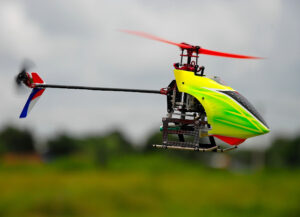
Helicopters in remote control have become increasingly
popular over the years as technology continues to advance. These miniature
versions of helicopters offer enthusiasts a way to experience the thrill of
flying without having to invest in a full-size aircraft. Whether you’re a
beginner or an experienced hobbyist, remote-controlled helicopters can provide
endless hours of entertainment. In this article, we will explore the basics of
remote-controlled helicopters and what makes them such a popular choice among
hobbyists.
Remote control helicopter
1. The Basics of Remote-Control Helicopters
Remote-control helicopters are miniature versions of the
real thing that are operated using a remote control. The controller sends
signals to the helicopter that tell it what to do, such as move forward,
backward, or side to side. These helicopters are powered by small electric
motors that are charged using a battery pack. The controller typically uses
radio waves to communicate with the helicopter, which means you can control it
from a distance.
2. Different Types of Remote-Controlled Helicopters
There are several different types of remote-controlled
helicopters available on the market today. Some are designed for beginners,
while others are more advanced and require a higher level of skill. Here are a
few of the most popular types of remote-controlled helicopters:
• Coaxial helicopters: These are the most basic type of
remote-controlled helicopter and are ideal for beginners. They have two rotors
that spin in opposite directions, which provides greater stability and makes
them easier to control.
• Single-rotor helicopters: These helicopters have a single
rotor and tail rotor that work together to provide lift and stability. They
require more skill to operate than coaxial helicopters but are more
maneuverable.
• Quadcopters: These helicopters have four rotors that
provide greater stability and control. They are ideal for aerial photography
and videography and are popular among hobbyists and professionals alike.

3. Advantages of Remote-Controlled Helicopters
There are many advantages to owning a remote-controlled
helicopter. One of the biggest advantages is that they are much more affordable
than their full-size counterparts. This makes them accessible to people of all
ages and skill levels. Additionally, remote-controlled helicopters are much
safer than full-size helicopters since they are small and lightweight. They can
be flown indoors or outdoors, depending on the weather conditions, and provide
endless hours of entertainment for the whole family.
4. Tips for Flying Remote-Controlled Helicopters
If you’re new to remote-controlled helicopters, it’s
important to take the time to learn how to fly them properly. Here are a few
tips to help you get started:
• Start with a coaxial helicopter: If you’re a beginner,
it’s best to start with a coaxial helicopter. These helicopters are easier to
control and provide greater stability, which will help you get the hang of
flying.
• Practice in a wide open space: When you’re first learning
how to fly a remote-controlled helicopter, it’s important to practice in a wide
open space where there are no obstacles. This will give you plenty of room to
maneuver and will help prevent crashes.
• Fly in calm weather: It’s best to fly your helicopter in
calm weather conditions since wind and rain can make it difficult to control.
Choose a day with light winds and clear skies for the best results.
• Be patient: Learning how to fly a remote-controlled
helicopter takes time and patience. Don’t get discouraged if you crash your
helicopter a few times. With practice, you’ll soon be able to fly like a pro.

Conclusion
Remote controlled helicopters are a popular choice among
hobbyists and provide endless hours of entertainment. They are affordable,
safe, and accessible to people of all ages and skill levels. Whether you’re a
beginner or an experienced flyer, there is a remote-controlled helicopter out
there for you. So why not take to the skies and experience the thrill of flying




